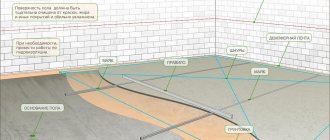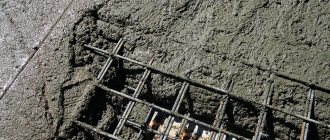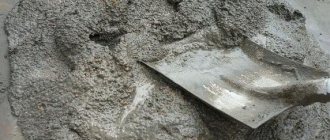However, often the quality of concrete floors in our apartments leaves much to be desired. In this case, it will be necessary to level the base. For this, either a ready-made dry mixture for floor screed or a sand concrete screed prepared by yourself is usually used.
No. 1. Pros and cons of dry mixes for screed
How was floor screed done before? Three to four parts of sand were added to one part of M400 cement. All that remained was to dilute the resulting mixture with water and pour it on the floor. A more advanced method involves adding plasticizers and fiber to improve the characteristics of the mixture. Many people still use this technology, even despite its many disadvantages. Not only is it heavy and dusty, but you will also have to mix a huge amount of mortar, so it will be difficult to do without a concrete mixer. A problem may also arise with the purchase of 100-300 kg of sand, since most sellers sell it at least per ton. These are not all the difficulties faced by those who want to save on screeds and do everything themselves.
You can overpay a little and buy a dry mixture for floor screed. In it, all the components are already dosed in accordance with the optimal proportions, and all you have to do is add the specified amount of water, mix the mixture using a drill with a special attachment and arrange the screed. Saves time, nerves and effort.
The main advantages of dry mixes for screed include::
- ease of preparation. The manufacturer did the most difficult and important part of the work for you - mixed all the components in the correct proportion;
- ease of mixing . After you have added the amount of water specified by the manufacturer, all that remains is to mix everything with a construction mixer or drill with the appropriate attachment. No special equipment, no concrete mixers - everything is simple and accessible;
- Almost anyone can perform screeding using dry mixtures - no special professional skills are required for this, and all the basic steps and tips, as a rule, are outlined even in the instructions on the packaging;
- transporting bags of dry mix (usually weighing 25 kg) is much more convenient than large bags of cement, buckets or truckloads of sand;
- the consumption of screed prepared from a dry mixture is less , which means the load on the floors will be lower. It is possible to achieve a reduction in consumption per 1 m2 thanks to the precise dosage of all components and the introduction of additional substances;
- it is difficult to arrange a regular screed with a thickness of less than 30 mm, since during the drying process such a base can become covered with cracks and collapse. In the case of dry mixtures, you can get a screed with a thickness of only 5 mm , and in its basic properties it will not be inferior to its classic counterpart. The reason is mentioned in the previous paragraph;
- the hardening time is shorter than that of classic screeds, since the composition includes special modifying substances that accelerate this process;
- a huge selection of ready-made compositions , so you can choose the most suitable solution for dry and wet rooms, and also find a screed that will dry record-breakingly quickly or have self-leveling properties.
The disadvantages usually include cost and the inability to control the components used by the manufacturer. As for the price, it is not that high, especially if you take into account all the numerous amenities. The quality of raw materials is becoming more and more difficult, so it is better to buy products from trusted brands that have been working in this field for decades.
Composition of the solution
Since the method of wet floor screed is taken as the basis, its composition will be exactly the same. The only difference is different proportions, as this is required to obtain the desired consistency. In this case, less water is taken to make the solution more plastic.
What exactly is included in the mixtures:
Water . It acts as a binding component that liquefies all the ingredients and makes them homogeneous, it binds them together.- Cement . It acts as a composite raw material and also binds other ingredients, further strengthening the overall mass, making it durable.
- Plasticizer. It is an additive to concrete solutions, it allows you to increase the fluidity and plasticity of the mixture. Often used when reducing the proportion of water and cement.
- Coarse sand . Added to the solution in order to ensure the volume of the material and the interaction of the components with each other. Coarse sand distributes stress on the floor, as a result of which the screed will not crack.
- Polypropylene fiber . Fiber fiber increases the strength and elasticity of the mixture; it protects the semi-dry screed from cracks when drying. This component also increases the impact resistance of the floor and makes it resistant to dynamic loads.
You only need to add cement to a semi-dry screed of a certain brand.
Component Requirements
It is not recommended to prepare a solution for semi-dry screed using raw materials not intended for this purpose. Each component will have its own requirements:
- Cement . Cement grade M500 is used. This is a binder for mortar. According to GOST 31108-2003, cement of this type can be marked as TsEM I 42.5 (for D0). The letter index D means the addition of ground slag: in this case, this slag should not be present. This raw material is frost-resistant, water-resistant and durable. It sets in solution no earlier than 45 minutes after preparation.
- Sand . It must be coarse-grained, washed or sifted. It should not contain large inclusions or various residues. The best option is first class sand with a particle size modulus of 2.5-3 mm.
- Water . The ideal option would be non-chlorinated well water. It should be cold or room temperature; water from untested sources should not be used, as the liquid may contain various waste particles and impurities.
- Plasticizer . Selected based on the needs of the solution.
Fiber fiber gives the screed plasticity and resistance to mechanical stress. To calculate this material, you need to take approximately 40 grams of fiber per 1 square of 50 mm thick floor mortar.
No. 2. Types of dry mixtures for floor screed
The range of mixtures is indeed huge, but all the variety that manufacturers offer us can be divided into two large groups:
- Cement mixtures are made based on different grades of cement. Depending on the brand, as well as on the fillers and modifiers used, compositions with different properties are obtained, which are used at different stages of surface leveling;
- gypsum mixtures are made, as you might guess, on the basis of gypsum; they are used less frequently, despite their low cost, since they are demanding in terms of operating conditions.
Difficulties of the concrete repair process
Repair of concrete surfaces using mortar or dry mixtures is required when the reinforcement is exposed, the material is destroyed, or the surface cracks down to the crushed stone filler. In the absence of restoration work, the structure may collapse.
There are the following difficulties in repairing concrete structures:
- cement grain has a dense structure and does not absorb liquids, solutions, standard masonry composition does not adhere to the base;
- The typical repair mixture shrinks and peels off on a concrete base.
To restore the integrity of the surface, specialized mixtures are used that are characterized by plasticity, a high degree of adhesion, and strength.
The product formula includes the following basic principles:
- dry polymer-cement and ready-made compositions;
- fibropolymer compounds consisting of sifted sand, acrylic and cement;
- compositions with epoxy resins.
No. 3. Cement mixtures for floor screed
The cement mixture is more expensive than gypsum and takes longer to dry, but it is almost universal and can be used in any premises: living rooms and bathrooms, apartments and shops.
Depending on the composition, the following types of cement mixtures are distinguished:
- mixtures for rough leveling are made using coarse sand, granite chips or even fine expanded clay. Such compositions are used when the difference in the base is significant and it is necessary to make a screed of impressive thickness. Experts use similar mixtures to construct screeds from 30 to 80 mm. In the end, although the surface is leveled, it does not become smooth, so you cannot do without another layer of screed (finishing), especially if a coating such as linoleum or laminate is being laid. If ceramic tiles or porcelain tiles are used, all unevenness will be leveled out during the application of glue, so you can do without a finishing layer of screed and save money. Such compositions can even be used outdoors as an independent coating. They are also suitable for installation on top of a heated floor system (it is undesirable to use a mixture with expanded clay). If it is necessary to level a floor with a difference of more than 80 mm, then it is better to use concrete, since the mixture in this case will be an extremely uneconomical solution;
- mixtures for finishing work contain fine sand (fraction up to 0.6 mm) and plasticizers. This composition allows you to obtain a perfectly even and smooth base, which is suitable for laying any type of facing material. The mixture is used when it is necessary to create a screed with a thickness of 4-5 mm to 10 mm. Often such mixtures are called self-leveling floors. If you need to strengthen the screed, you can additionally use a fiberglass reinforcing mesh or immediately take a mixture that includes fiber. It makes sense to use such reinforced compounds when a truly increased load on the base is expected, otherwise there is no point in overpaying;
- self-leveling mixtures contain filler with particles less than 0.3 mm and special additives. Due to this, the finished composition has excellent fluidity and the ability to self-level under the influence of gravity. Such mixtures are used as a finishing base; the recommended layer thickness is up to 5 mm. This screed dries quickly, gives excellent results with minimal effort, but is more expensive than other types;
- mixtures for heated floors are produced using plasticizers, which “expel” all air bubbles during the screed hardening process. The latter are a kind of heat insulators that prevent the flow of heat from the heated floor into the room. It turns out that in this way the thermal conductivity of the screed increases. In addition, these compositions boast high plasticity and inertia, which is important with frequent changes in temperature. Of course, when installing heated floors, other types of screeds are also used, but to get an effective system, it is better to use a special composition.
No. 4. Gypsum mixtures for floor screed
Gypsum compounds are used less often than cement ones, due to their lack of versatility. They are produced on the basis of finely ground gypsum with an admixture of various mineral fibers and sand. The main advantages of such compositions include:
- high drying speed;
- high strength;
- low price;
- environmental friendliness, no dust during cooking;
- high rates of heat and noise insulation.
The main disadvantage is that gypsum mixtures are not resistant to moisture, so they can only be used in residential areas. Experts say that gypsum composition is an ideal option for screeding wooden floors, since such a base can effectively regulate the level of humidity, keeping the wood in its original state for a long time.
A gypsum screed will dry for 14-15 days, a cement screed for 25 days. During this period, it is impossible to carry out further cladding work. If you can’t wait, then use dry screed technology . To do this, use a backfill based on expanded clay chips or polystyrene granules. The material is compacted and leveled along the beacons, and sheet material (plasterboard or OSB board) is laid on top. No water is used, so there is no need to wait for everything to harden. You can start the next stage instantly.
No. 5. Calculation of dry mixture for screed
Perhaps the issue of cost worries us sometimes even more than the quality of the resulting screed. The price depends on how many bags of mixture you need . It is not difficult to calculate this amount. The procedure is as follows:
- We determine the floor area and the thickness of the future screed layer. The last parameter depends on the degree of unevenness of the main surface. Let's say we are screeding in a room 3*4 m (area 12 m2), and we will need a layer 13 mm thick;
- We carefully study the packaging of the selected mixture and look for the mixture consumption parameter. The manufacturer usually indicates the consumption in kg per 1 m2 with a layer of 10 mm. At this stage, you can study the declared characteristics of several mixtures and compare the results obtained. Some nameless companies (read unscrupulous fly-by-night manufacturers) may deliberately underestimate consumption. For example, let's take the Bergauf Base mixture with a consumption of 22 kg;
- if for 10 mm of screed the mixture consumption is 22 kg/m2, then with a layer of 13 mm you will need 1.3 times more mixture (13/10 = 1.3). For 1 m2 of screed we will need 22*1.3=28.6 kg, and for the whole room it will take 28.6*12=343.2 kg of the mixture. Just in case, it is better to add a margin of 5%. You will get 360.36 kg of mixture;
- dry mixes are sold in bags of 25 and 50 kg. The Bergauf Base taken as an example is supplied in 25 kg bags. You will need 360.36/25 = 14.4 bags, round up and buy 15 bags of 25 kg each. Should be enough. The average cost of one bag of such a mixture is 230 rubles, i.e. you will need 3,450 rubles, and as an example we took far from the cheapest composition.
Leveling technology (step-by-step instructions)
For the leveling process, it is customary to prepare the following tools:
- Wide spatula;
- Needle roller;
- Container for solution.
The zero mark is always determined using a level. The primer should always be applied using a roller or brush.
- Before work, you need to find two points: the highest and the lowest.
- It is also important to measure the difference between them. This is important for calculating the leveler consumption.
- It is always written on each package. Technical indicators of composite consumption per square meter.
- Next, you need to determine the area of the room in square meters, and then estimate the material consumption.
- After this, you can prepare the surface. Use a metal spatula to remove construction debris.
It is also important to seal any gaps in the wall surface. Small cracks can be sealed with a deep penetration primer.
It is always necessary to carefully study the composition of the primer used. You need to work with a roller that can reach hard-to-reach areas.
If the primer absorbs too quickly in any area, it is best to apply a second coat. Leveler - the mixture is best stirred with a drill to eliminate small bubbles.
First, liquid is poured into the container, and then the leveler is gradually added. Apply the leveler with a spatula and carefully level the surface. As soon as the layer dries, you can lay the floor covering on the leveler.
No. 6. Large manufacturers
The manufacturer is responsible for the quality of the product with its reputation. If you want to be sure that the proportions are correct and the indicated consumption is adequate, then it is better to buy mixtures from trusted manufacturers. Among the largest we note the following:
- Knauf is a German company that, among other things, produces dry building mixtures. For floor screed there is a cement and universal gypsum-cement self-leveling screed. The cement composition costs about 500 rubles. for 25 kg;
- Ceresit produces a wide range of cement and gypsum compositions. The universal composition CN 175 will cost approximately 400 rubles. for 25 kg, and self-leveling mixture DD for creating screed with a layer of up to 5 mm - 850 rubles;
- Bergauf produces a lot of solutions for roughing and finishing floors. For basic leveling, Base mixtures (about 230 rubles for 25 kg) and Erste Grund are suitable; for finishing you can use Easy Final (300 rubles) and Boden Nivelir, there are self-leveling mixtures;
- Osnovit is one of the most famous domestic manufacturers, producing rough, finishing and high-strength compositions, as well as mixtures for use with heated floors. Prices are moderate. A 25 kg bag of FC44 M mixture costs about 175-220 rubles;
- Unis offers the widest range of floor screed mixtures. There are roughing and finishing compositions, reinforcing and quickly hardening mixtures, as well as self-leveling and high-strength compositions. A 25 kg bag of mixture for rough work will cost 205 rubles.
It is also worth noting the products of the brands Ilmax, Ivsil, “Poligran” and “Sarmat ”. It doesn’t hurt to look online before purchasing and read reviews about the specific composition of a particular manufacturer.











